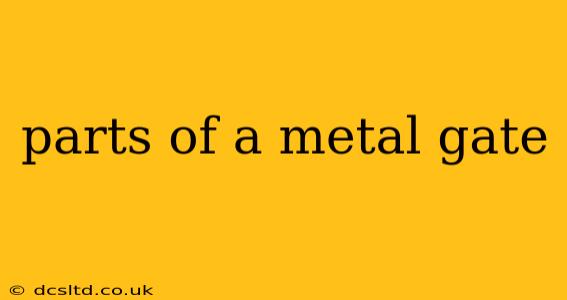Metal gates, whether securing a sprawling estate or a cozy backyard, are robust structures composed of several key parts working in harmony. Understanding these components is crucial for maintenance, repair, and even design considerations. This guide delves into the essential parts of a metal gate, explaining their function and significance.
What are the Main Parts of a Metal Gate?
The core components of a metal gate typically include:
-
Frame: This forms the gate's skeleton, providing structural integrity and support for all other elements. It's usually constructed from strong metal profiles like rectangular tubing or angle iron, chosen for their strength and resistance to bending or twisting. The frame's dimensions determine the overall size and shape of the gate.
-
Infill: This is the material filling the space within the frame. Common infill materials for metal gates include:
- Metal Bars: These offer a classic, sturdy look and can be arranged in various patterns (horizontal, vertical, diagonal).
- Metal Panels: Sheets of metal, often perforated or with decorative cutouts, provide a more solid and aesthetically pleasing look.
- Wrought Iron: This decorative metalwork creates intricate and visually striking designs.
- Mesh: Wire mesh infill is ideal for visibility and ventilation.
-
Hinges: These pivotal components connect the gate to its posts, allowing it to swing open and closed. They are usually made of robust metal, designed to withstand heavy use and the weight of the gate. Different hinge types exist, including butt hinges, tee hinges, and strap hinges, each with its own strength and aesthetic characteristics.
-
Latch/Lock: This secures the gate in the closed position. Options range from simple latches to complex locking mechanisms offering varying levels of security. These mechanisms are typically integrated into the gate frame or a separate post. Common types include padlocks, surface bolts, mortise locks, and electronic locking systems.
-
Posts: These are the vertical supports that the gate hinges onto. Posts are crucial for stability and are usually made from materials like concrete, steel, or wood, often encased in concrete for added strength.
What are the Different Types of Metal Used in Gates?
The choice of metal significantly impacts a gate's durability, aesthetics, and cost. Common metals used include:
- Steel: A popular choice due to its strength, durability, and relatively low cost. Galvanized steel offers added corrosion resistance.
- Aluminum: Lighter than steel, aluminum is corrosion-resistant but less robust. It's often preferred for gates in coastal areas.
- Wrought Iron: Known for its intricate decorative possibilities and strength, wrought iron is a more expensive option.
How Do I Choose the Right Metal Gate for My Needs?
Selecting the right metal gate depends on various factors:
-
Security Requirements: High-security areas might need gates with reinforced frames, robust locks, and potentially added security features like alarm systems.
-
Aesthetic Preferences: The style of your home and landscaping will influence your choice of infill material and overall gate design.
-
Budget: Costs vary significantly depending on the size, materials, and complexity of the gate.
-
Climate: In harsh weather conditions, corrosion-resistant materials like galvanized steel or aluminum are preferable.
What are the Common Problems with Metal Gates?
Over time, metal gates can suffer from:
-
Rust: This is a common issue with ungalvanized steel gates, requiring regular maintenance and potential repairs or repainting.
-
Sagging: Due to the weight of the gate or damage to the hinges, the gate may sag over time.
-
Loose Hinges or Locks: Regular tightening and lubrication can prevent this issue.
-
Corrosion: Exposure to the elements can cause corrosion, especially in gates made of less resistant metals.
Understanding the various parts of a metal gate, their functions, and potential problems is essential for ensuring its longevity and security. Regular maintenance and timely repairs can significantly prolong the lifespan of your metal gate and maintain its aesthetic appeal.
